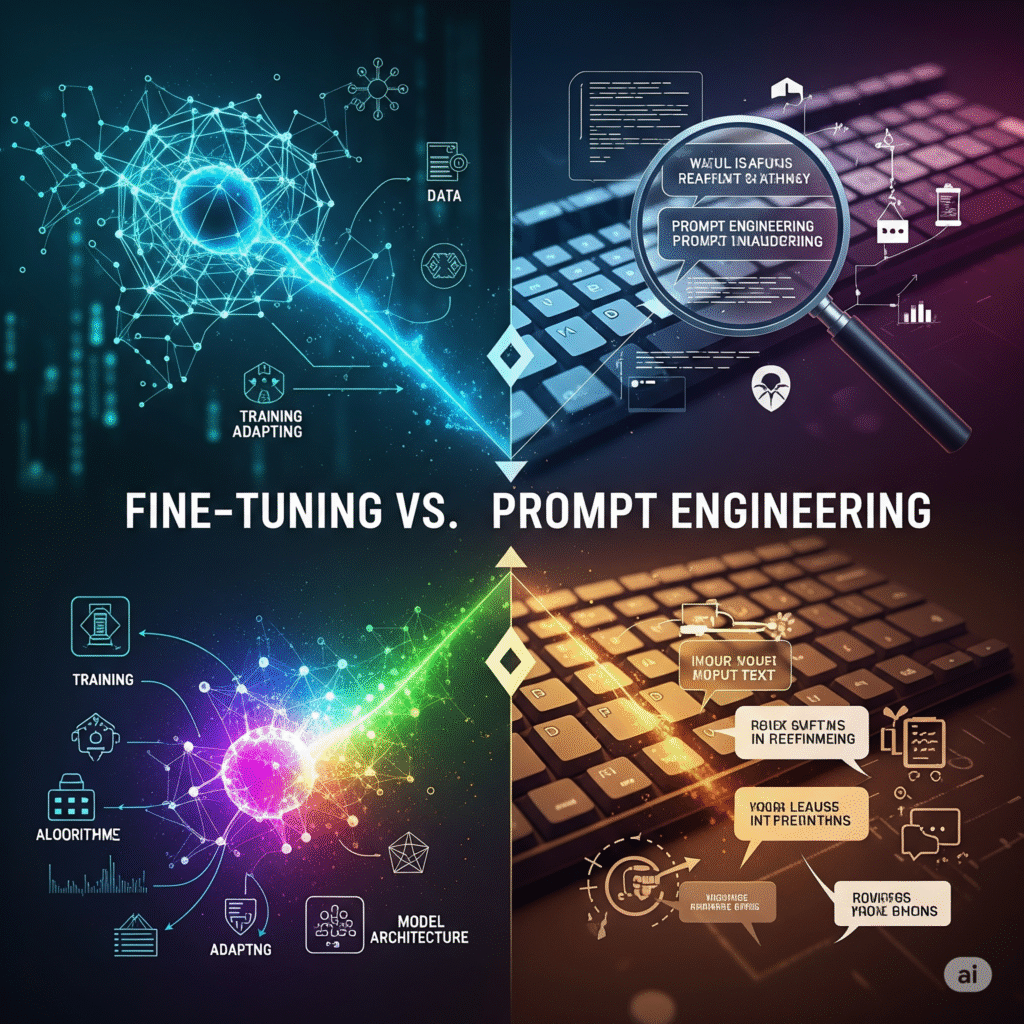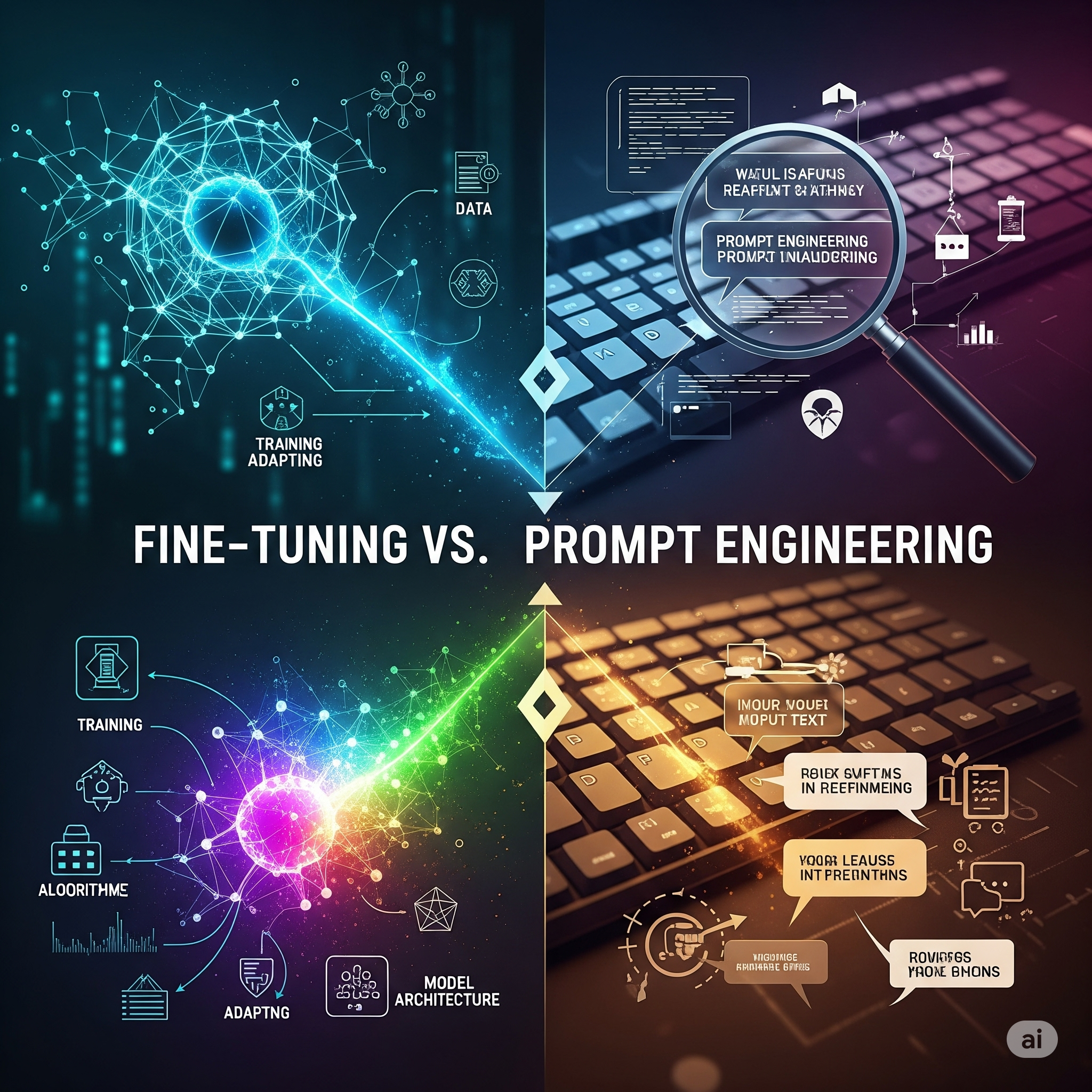In the fast-evolving world of Artificial Intelligence particularly with large language models (LLMs) like OpenAI’s GPT-5, Anthropic’s Claude, and Meta’s LLaMA, two optimization approaches dominate technical and business discussions: prompt engineering and fine-tuning.
Both are powerful in their own right, but they differ in cost, complexity, scalability, and strategic value. Selecting the right approach can determine whether your AI delivers mediocre outputs or becomes a mission-critical asset driving measurable ROI.
This guide dives deep into both methods, unpacks their strengths and limitations, and provides a decision-making framework to help you choose the best fit for your use case.

What is Prompt Engineering?
Prompt engineering is the art and science of designing precise, context-rich inputs to guide an AI model’s behavior without modifying the model itself. It’s about leveraging what the model already knows and steering it toward desired outputs.
Think of it as giving a highly intelligent assistant clear, structured instructions—the better you phrase your request, the better the result.
Key Advantages of Prompt Engineering:
- No retraining required – Works with off-the-shelf models.
- Low barrier to entry – Can be learned and applied by non-technical users.
- Rapid iteration – Test, refine, and deploy in minutes.
- Cost-effective – No need for additional compute resources or proprietary datasets.
- Highly flexible – Adaptable to different domains and changing requirements.
Example:
Generic Prompt:
“Explain quantum computing.”
Engineered Prompt:
“You are a university physics professor. Explain quantum computing in simple, everyday language for a high school audience, using analogies and no technical jargon.”
By defining role, audience, and style, the model produces far more relevant and accessible content.
When Prompt Engineering Excels:
- Rapid prototyping of AI-powered features.
- Startups or teams with limited AI budgets.
- Projects with dynamic or evolving requirements.
- Scenarios requiring a variety of outputs from the same model.
What is Fine-Tuning?
Fine-tuning is the process of taking a pre-trained AI model and further training it on a specialized dataset so it learns domain-specific knowledge, style preferences, or task-specific behaviors.
Instead of relying on elaborate prompts to “tell” the model what you want, fine-tuning bakes the desired behavior directly into the model’s weights.
Key Advantages of Fine-Tuning:
- Domain mastery – The model learns niche industry language, concepts, and workflows.
- High output consistency – Responses follow specific formatting, tone, or compliance rules without repeated instruction.
- Reduced prompt complexity – Minimal instructions needed once the model is trained.
- Scalable reliability – Ideal for production environments with repetitive, high-value tasks.
Example:
A law firm fine-tunes an LLM on thousands of legal documents and precedent cases. The resulting model can:
- Draft contracts in the firm’s preferred structure.
- Analyze clauses for legal risk.
- Provide citations to relevant laws automatically.
When Fine-Tuning Excels:
- Long-term, stable AI-driven workflows.
- High-stakes domains like medicine, law, or finance.
- Use cases requiring strict brand voice or regulatory compliance.
- Enterprises with large proprietary datasets.
Fine-Tuning vs. Prompt Engineering: Key Differences
| Feature | Prompt Engineering | Fine-Tuning |
|---|---|---|
| Setup Time | Minutes to hours | Days to weeks |
| Cost | Low | High |
| Technical Skill | Low to moderate | High |
| Flexibility | High | Medium |
| Consistency | Medium | High |
| Best For | Quick changes, diverse tasks | Stable, specialized tasks |
How to Decide Which to Use
To choose between prompt engineering and fine-tuning, ask yourself:
- Do you need speed and adaptability? → Use prompt engineering.
- Do you require deep domain expertise and consistent tone? → Choose fine-tuning.
- Is budget a limiting factor? → Start with prompt engineering.
- Do outputs need to be compliant or risk-free? → Fine-tuning is safer.
Hybrid Approach: Best of Both Worlds
In 2025, many AI-first organizations are adopting a hybrid workflow:
- Start with prompt engineering to quickly iterate and discover the ideal behaviors.
- Once requirements stabilize, fine-tune the model for consistent, scalable results.
- Use prompt engineering even after fine-tuning to tweak outputs without retraining.
This approach combines agility with long-term reliability.
Pros & Cons Summary
Prompt Engineering
✅ Low cost, fast iteration, adaptable to many tasks.
❌ Requires complex prompts for consistency.
Fine-Tuning
✅ Domain-specific accuracy, predictable outputs, brand alignment.
❌ Higher cost, slower to update.
Conclusion
As LLMs become central to enterprise AI strategies, understanding when to use prompt engineering versus fine-tuning is no longer optional, it’s a core operational decision.
Prompt engineering is your low-cost, rapid experimentation tool, perfect for adapting to changing needs. Fine-tuning is your long-term investment, locking in precision, brand voice, and compliance at scale.
The smartest teams don’t choose one, they combine both strategically, starting lean and flexible, then committing resources to fine-tuning once the ROI is proven. This ensures you get fast innovation today and dependable performance tomorrow, a winning formula in the age of intelligent automation.
Related Reads
Agentic AI Interview Questions – Part 2
External Resources
OpenAI – Fine-Tuning Guide
https://platform.openai.com/docs/guides/fine-tuning
Anthropic – Prompt Engineering Best Practices for Claude
https://docs.anthropic.com/claude/docs/prompt-engineering
Hugging Face – Fine-Tuning Transformers
https://huggingface.co/docs/transformers/training
Cohere – Prompt Engineering Techniques
https://docs.cohere.com/docs/prompt-engineering
LangChain – Combining Prompt Engineering with Fine-Tuning
https://docs.langchain.com/docs/integrations/model-finetuning


4 thoughts on “Prompt Engineering vs. Fine-Tuning: Choosing the Right Strategy for Optimizing LLMs in 2025”